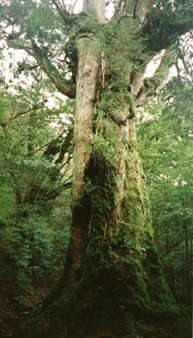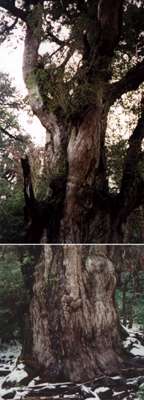|
Once I muster up the courage to leave the cosy down bag, I pile on my thermal shirt, fleece top and bottom, a down jacket, gloves, beanie, socks and boots and gingerly slide the aluminium door. If this island was beautiful yesterday, this morning it is glorious. Behind the obligatory piles of building debris, discarded tins and cord, the intensity of green in the morning sunlight around the hut makes neon look wan. I sun myself like a lizard for a minute, then disconnect a camera from my pack strap and stumble about, trying not to trip over my untied laces. I stomp (in an effort to keep my toes warm) back down the trail to look once more at the stream and the sugi which straddles the path on its splayed timber legs. I backtrack still further along the trail to a spot where the paved path becomes stepping stones across the damp soil. My stomach says "eat breakfast". My feet remind me that I will have plenty of walking to do in the forwards direction before the day is done. My camera photo counter reminds me that there will be many more opportunities without going back on my tracks. Everything is suggesting I return to the hut to eat breakfast. I can't help but linger and wonder. I boil some water and make hot muesli and a mug of tea... yum! Nothing like a hot breakfast on a chilly (to say the least) morning, in the most beautiful mori (forest), in a patch of sunshine which comes and goes as the clouds tease me. The trail through the forest this day is truly spectacular, awe-inspiring, over-coming, astonishing... I do not think English has sufficient means to describe it. Even if I'm mistaken in this regard, I know I don't have the ability to do the island justice. Every turn reveals trees twisted and wise, old and powerful. Maybe magical might be defined by reference to these woods. Yes, that must be as near an adjective as I will find. If ever a place was magical, Yakushima must be it. |
||
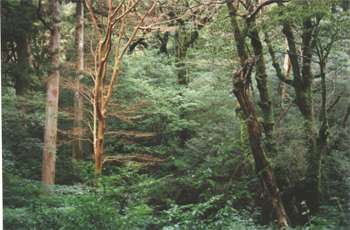 |
Magic is not something you laugh at for a fleeting moment of amusement. It is not a passing sensation. Magic is not something seen from a particular vantage point or in a stunning vista. It is not something you breathe on the light air. Magic is the wonder a child experiences when his father pulls twenty cents out of his ear. It is inside. On Yakushima, every pebble and every boulder, every twig and every trunk, every frond of moss or tropical leaf, every muddy clod, patch of snow, whiff of damp air, everything, is just so.... ALIVE... That is magic. To be raised here is to take animism for granted. To visit is to discard or discount any religion which does not grant the trees and rocks a soul. |
|
|
Aristotle, the first to recognize the life-force of plants, must surely have visited Yakushima in his dreams. Here it is clear that life is not peculiar to animals. Had he visited this place in the flesh, Aristotle must surely have agreed with indigenous Australians, sculptors and Yosemite's El Capitan climbers, that rock is as spirited as mammal. Despite the conflict induced by half of my brain, I found myself apologizing to the moss when I squished it into the mud under foot. The boulders which held my boots firmly I thanked for allowing me safe passage. The snapping underfoot of twigs dry enough to do so had me cringing in sympathy. This day I understood the term "tree hugger". I hugged many trees and laid a palm on many others as I passed or climbed over and under their feet. What did I feel? Sometimes sympathy, sometimes weight. Sometimes the trees felt tired, sometimes they did not notice my touch. Some shivered at the tickle, others twitched at the irritation. All of them were cold and earthy. Whether fallen or proud, twisted or upright, all were cold and earthy. These sensations too are those of life. Warm and cool. ALIVE. |
||
| The path opens out at a T-junction. Across the top of the T runs a miniature railway. Timber sleepers lie at three foot intervals stretching beneath rusty iron track to the left and right. How many trees were cut to build this obscenity? I hunt through the stapled and photocopied pages from my guidebook. This was a logging railway. My stomach turns. The rushing of the water from the stream below me at the cliff base mixes with the boiling of the blood in my ears. I read on. The railway is disused. Well that's a relief. |
 |
|
| The island has a history of logging... remember the shingles? I sigh and dump my pack whilst I enjoy the sun (which has firmly re-appeared) and munch a raisin biscuit or five with a lemon flavoured boiled lolly for dessert Ð a feast. | ||
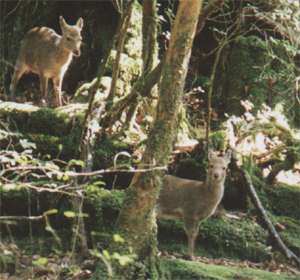 |
The path follows the railway for a couple of kilometers. Deer grazing by the iron tracks turn to watch me pass. I slow so as not to startle them. They are not afraid. This place is magic. There is nothing to fear. They are protected by the forest's spirit. No, they are a part of the forest's spirit. I am becoming a part of the forest's spirit. The iron and timber tracks are a part of the forest's spirit. They are a scar which is slowly healing. One day, when the iron has rusted, the sleepers have rotted and have been replaced by moss and fungus, only the strip of fresh skin on the forest canopy will testify to the cruelty of men. I hope this is the way, for the other path is too abhorrent to contemplate. The iron twists violently and stops abruptly. I halt overlooking a rushing torrent of melting snow. |
|
|
The bridge is out, and has been for some time. I stand in a puddle and gaze into the white water to let it wash away the accumulated mental grime of city life. I detour upstream where the rocks allow dry passage. Further along, a sunny bridge crosses a peaceful stream. I balance my pack at the far end. Oooops... slip dis(un)-gracefully down the muddy slope to the water to fill my bottle then climb back onto the bridge. Shirt, boots and socks off Ð it is warm enough to sun-bake on the narrow shelf, as long as I don't sleep between the sleepers! Munching on some salty local biscuits and peanuts when... "Konichiwa! Sumimasen, sumimasen." In a land of one hundred and some million people, I seem to have three visitors. Two women, perhaps in their late forties (I'm useless at ages in Japan) and one in her early thirties are standing by my pack laughing at my surprise... or my shirtless torso? I must work out more. My muscles are sinewy now instead of bulky. Too much cycling, too much rice and pasta. Not enough meat (on me and in my diet). I know, I know, they are saying to one another "That man is a gaijin, isn't he?" |
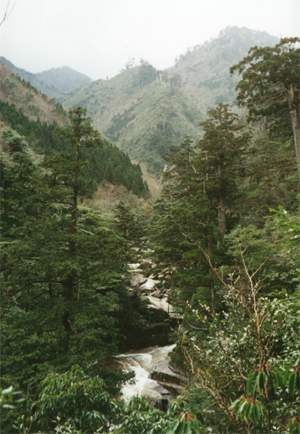 |
|
| One of
the women holds up a finger and asks me if I'm alone. Should I reach for
a weapon and tell them yes? Or should I run off into the woods shouting
"No! The forest is my friend! The trees are my allies! You will never
take me alive!"? (That ought to bewilder them.) I smile and nod, "Hai.
Sumimasen", I rise to put on a shirt and to stand at the edge of the narrow
bridge that they might pass. "Sumimasen, sumimasen" they chime, indicating
for me not to move. I sit still as they climb around me. The young girl
smiles and gives me another "konnichiwa" as she passes. The
last of them grins then calls to the others as she points at my boots
drying in the sun. "Ooohhh, oki desu ne". I wish I could satisfactorily
put her intonation into the text. "Chigau, chisai des!" I reply grinning...
she is talking about the size of my boots. This has been a most amusing
encounter. "Sayonara" they chime as one and disappear down the railway*.
None of them was carrying a pack. I suppose they are walking back along the railway until it meets a road but I can't be bothered checking the map. I am pleased that I am not alone in appreciating this place. I am thrilled that out of all of the hundred and some million Japanese, three women have the sense of adventure required to set foot here and to leave the internal combustion engine at the gate. |
||
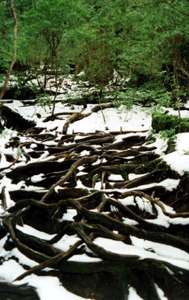 |
Time now to stop treading the scar and to climb a short ladder into the forest. Peak hour! I wait for two girls and a thirty-something year old man to climb down the ladder before I ascend. The guy looks me over and nods. He holds up a finger and asks me if I'm alone. "Hai." Maybe everybody feels sorry for me that I haven't got any friends. As I move into the forest ominous clouds move into the sky. Climbing further and further in the mushy soil, the patches of snow stretch to meet one another. In places the blanket is nearly complete. The path is muddy where people have trodden the snow and turned up the earth beneath it. I pull out my gators to wade through the slush which at times comes to my ankles. My feet are most certainly wet. The water in my socks goes squish as I wriggle my toes.
|
|
|
The trees become more and more immense as I move deeply into the forest. A light drizzle is descending through the canopy. The path becomes so steep and weathered I am forced to move along a channel in the earth where the water has washed it away. At the bottom of this channel it is invariably muddy or snow- filled. Sometimes the channel is so deep and narrow that my pack rubs the sides, widening the hole further and coating me with mud. Sometimes a large rock or tree root has stopped the erosion, making a huge step of five feet in the channel. With no easy way out of the ravine and these huge steps to negotiate, the climb is tedious and muddy work. The path continues to climb. Timber ladders have been placed to assist in the climb and prevent further erosion. Viewing platforms are suspended on the mountain sides looking out at the impressive, moss-smothered, twisted forms of Yakusugi (I.e. Sugi from Yaku-shima). |
|
|
|
The Yakusugi are sugi trees which have reached a particular level of grandeur. These trees are prized for their great wisdom. Like the elderly men one sees in country towns throughout Japan, their backs bent, their faces as coarse as the bark of the sugi, their eyes smiling more broadly than a mouth ever did, the yakusugi are highly respected. The rain becomes more heavy as the path twists further and further upwards. Occasional runs downhill are met with more steep rises in retaliation. Always, the trees stand like an army of the massive timber warriors you find in the gates of the temples here. |
||
|
My favourite of these warriors is the pair in the Nandaimon gate at Todaiji near my house in Nara. These two fearsome characters must be twenty five metres high. Their arms are hefty, their legs are solid as oaks. No Hollywood cyborg would stand a chance. Mere mortals would crumble to dust should their gaze be met. Wilson's Kabu... the stump of a warrior, cut at the ankles in the 1500's by more than ten men with saws. This was not a fair contest. The warrior trusted the men who betrayed it. The warrior had stood for three thousand years watching the forest in which they lived. The combined ages of those who slaughtered it were but a speck by comparison. Es tu Brute? The Yakusugi's remains were rediscovered last century by a botanist (Wilson) and re-named accordingly. |
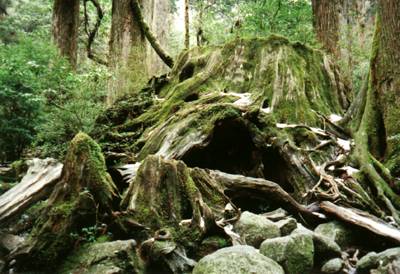 |
|
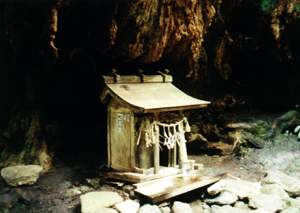 |
The massive stump houses a Shinto shrine of about one cubic meter, from beside which a spring issues - clear blood running continuously in the grit. The warrior's life continues to flow into the forest. In the dim, circular room I am reluctant to fire my camera's flash. I tip my head and gaze through the hole in the roof where the warrior once stood. Sugi around this corpse tower into the grey sky. The steady rain falls onto my face and into my eyes. I re-align my aching neck and crouch to touch the soil. Coins given as offerings to this tree are scattered at the base of the tiny shrine in its heart. This is a place more befitting of Merlin than any I have known. This is a place more befitting of Merlin than any I might have imagined. | |
|
|
With reluctance I leave the enchanted corpse and continue in the mud and snow, past countless sentinels who have guarded so long that the moss has covered them from head to foot. Now I tread humbly in the mud between their toes and gaze up at their chins. Their green faces are turned to meet the rain which runs in seventy-meter trickles down onto my own. | |
| Jomon-sugi, at an astonishing 7200 years, is old and tired. This once fierce warrior now possesses a different power - wisdom surpasses physical strength. Jomon-sugi stands hunched and contorted, a small space clear around its feet in which to practice the magic which unites the forest. |
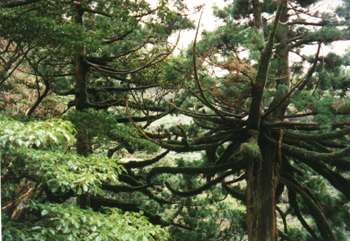 |
|
|
|
The rain is easing as I climb to the saddle on which is nestled Takatsuba-goya (hut). Glistening red timber sinew weaves through the air amongst the dark sugi, firs and other vertically-oriented creatures. Snow blankets the ground. Occasional thickets of bamboo grass give the saddle the appearance of a well-organized garden. Takatsuba-goya is double-storied (well, kind of). It is a little smaller than my previous night's accommodation, but still too cavern-like for one. The smell of wet ash in the fireplace permeates my clothes as I breathe fog into the flames of my stove in the open doorway. | |
| The wind is picking up. The rain comes and goes as I cook, eat and unpack my cocoon. I hurriedly peel off my sodden clothes and jump into some dry thermals before diving into the depths of my cosy sleeping bag. The snuffed candle smokes briefly, a last ember glows then blackens abruptly. The wind howls outside, casting its spells as I draw the hood cord and relax. This place is magic. There is nothing to fear. |
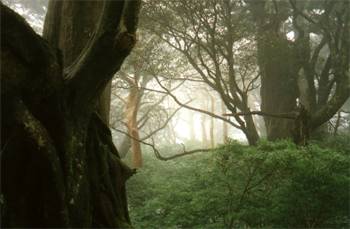 |
|
*It is at times like these I miss not being able to ask people to stay and share my biscuits and a chat.Who are these three? Where do they live? Are they office ladies? Adventurers? House-wives? I will never know.
